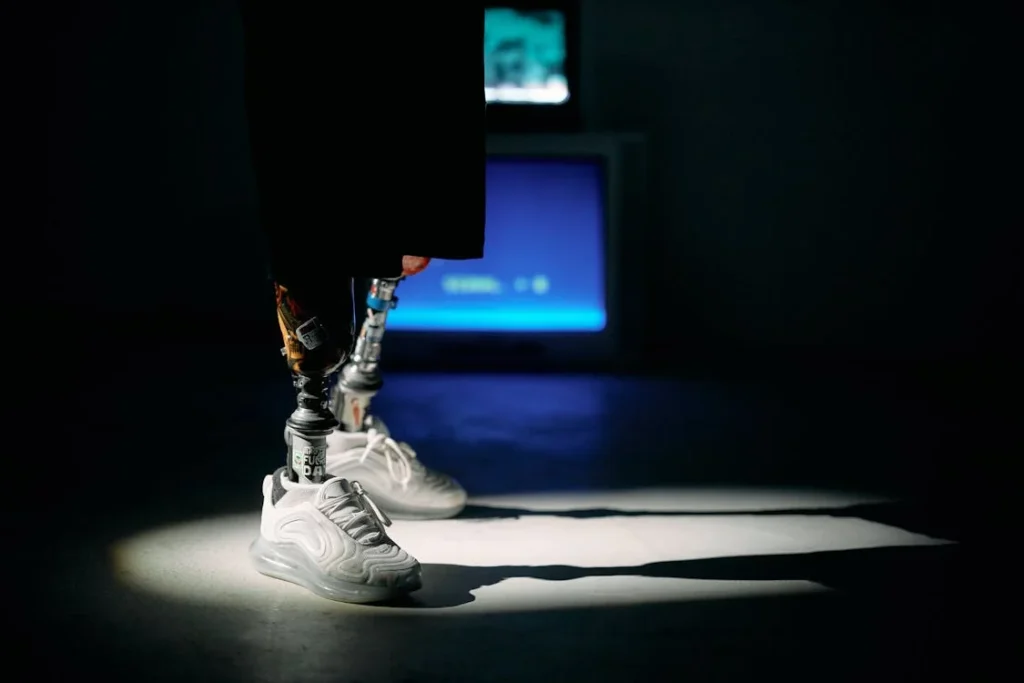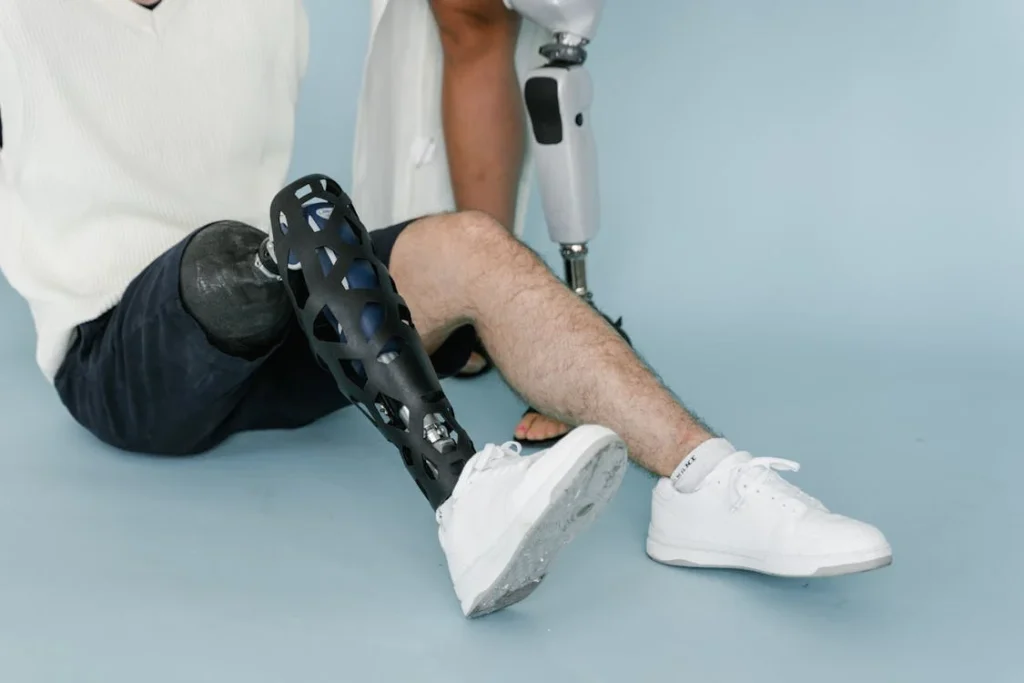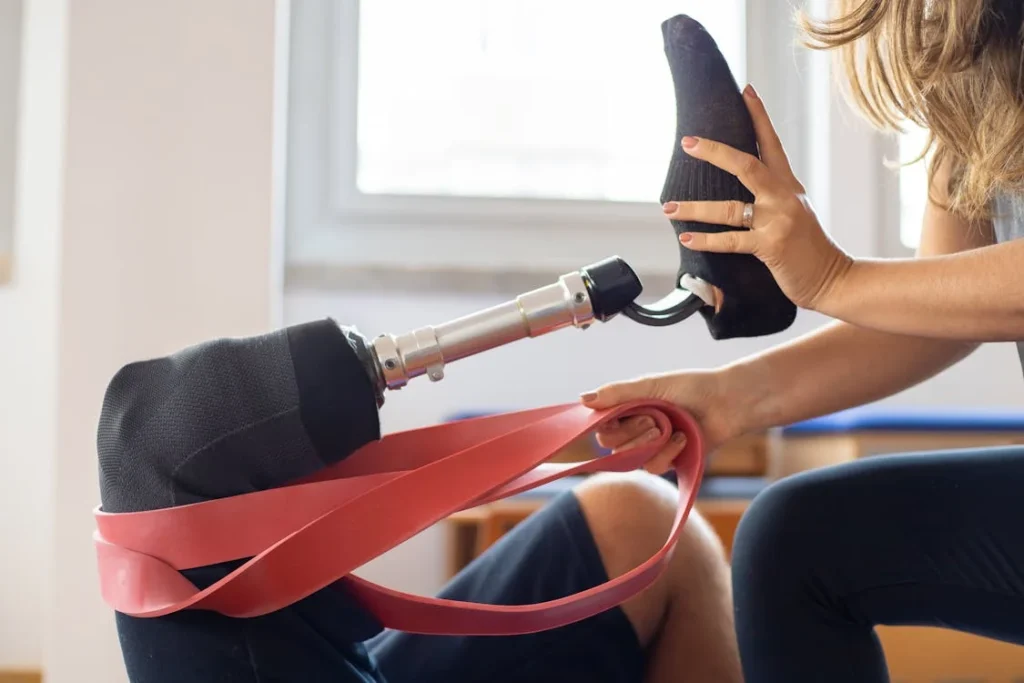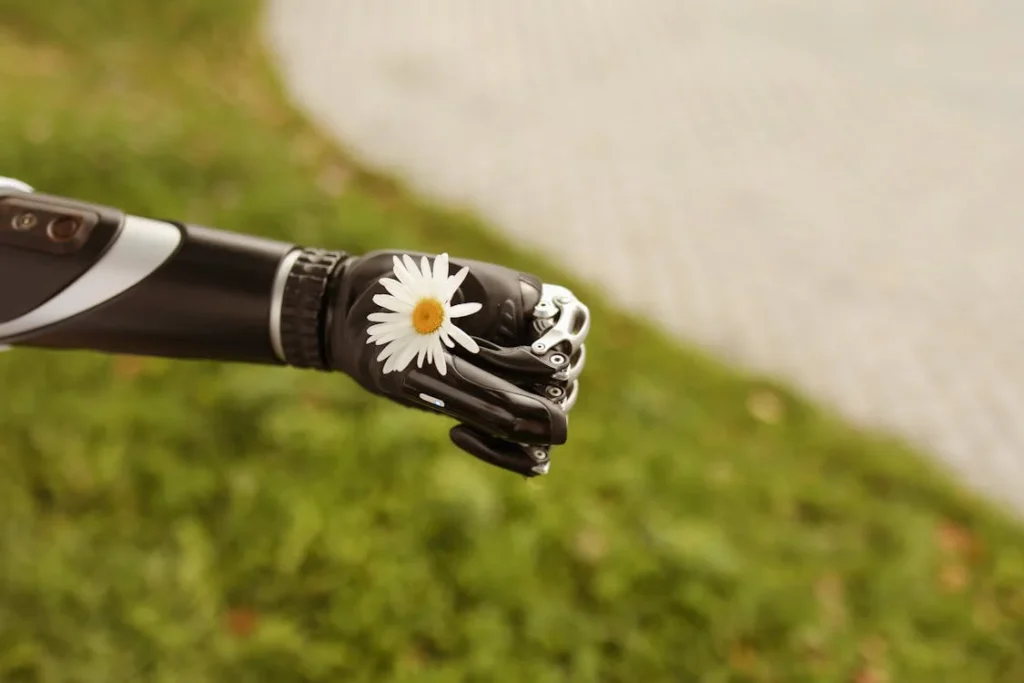Prosthetic devices are remarkable tools that restore mobility, independence, and confidence. However, like any device, they are not immune to occasional hiccups.
A loose strap, an uncomfortable liner, or a squeaky joint can disrupt your day and affect your confidence in using your prosthetic. While professional care is crucial for complex issues, there are simple, effective fixes you can try for everyday problems to keep your prosthetic functioning smoothly.

Addressing Fit and Comfort Issues
Fit and comfort are at the core of a successful prosthetic experience. When a prosthetic device fits well, it not only enhances mobility but also minimizes discomfort, irritation, and potential long-term complications.
Addressing fit and comfort issues promptly can transform the user’s daily experience, allowing them to focus on living their life without constant distractions from their device.
Understanding the Root Causes of Discomfort
Discomfort with a prosthetic device can arise from multiple sources, such as:
- Volume changes in the residual limb: Natural fluctuations due to temperature, activity levels, or weight changes can impact how well the prosthetic fits.
- Improper donning: Incorrectly applying the liner or socket can create pressure points or instability.
- Material wear: Over time, liners and sockets may degrade, leading to reduced cushioning and increased friction.
Identifying these root causes is the first step in addressing fit and comfort issues effectively. Encourage users to monitor how their prosthetic feels throughout the day, noting when and where discomfort occurs, as this information can guide solutions.
Immediate Adjustments for Better Fit
For minor fit issues, small adjustments can make a significant difference. If the prosthetic feels loose, users can experiment with prosthetic socks of varying thicknesses.
These socks help fill gaps caused by residual limb volume changes and can restore stability without requiring a full refitting.
Teach users how to properly layer or remove socks based on their comfort needs. For example, adding a thin sock in the morning when the limb is at its smallest and removing it later in the day as swelling occurs can prevent discomfort.
If the liner or socket feels misaligned, encourage users to reapply their device with careful attention to positioning. Even a slight adjustment in how the liner is rolled onto the residual limb can impact overall comfort and fit.
Providing step-by-step guidance on donning techniques—such as using a mirror to check alignment—can help users achieve a more consistent fit.
Preventing Skin Irritation
Skin irritation is a common side effect of poor fit, but it can often be prevented with simple measures. Recommend hypoallergenic or moisture-wicking liners to users prone to sweat or skin sensitivity.
For additional protection, users can apply a prosthetic-compatible barrier cream to reduce friction between the skin and the device.
If users report consistent irritation, encourage them to inspect their liner for signs of wear, such as thinning or tears. A worn liner loses its ability to cushion and protect the residual limb, often leading to discomfort.
Businesses can promote regular liner replacements as part of a preventative care plan, offering discounts or subscriptions to make replacements more convenient and affordable.
Long-Term Solutions for Persistent Fit Problems
For users experiencing ongoing fit challenges despite temporary fixes, a more comprehensive solution may be necessary.
Residual limb volume changes, which often occur in the months after an amputation or due to lifestyle shifts, can significantly affect how a prosthetic fits. In such cases, a refitting or custom socket adjustment by a prosthetist may be required.
Businesses can help users by offering routine refit assessments as part of their follow-up services.
During these sessions, prosthetists can evaluate the current fit, adjust the socket, or recommend upgrades such as dynamic or adjustable sockets that adapt to volume changes more effectively.
If a user’s lifestyle changes significantly—such as taking on a more physically demanding job or engaging in new sports—ensure they understand how this impacts their prosthetic needs.
Offering personalized consultations to match their activity levels with the appropriate adjustments or devices reinforces your commitment to their comfort and success.
The Role of Advanced Technologies
Innovative technologies, such as pressure-mapping systems and 3D scanning, are transforming how businesses address fit and comfort issues.
Pressure mapping can pinpoint areas where excessive pressure or gaps occur, allowing prosthetists to make highly targeted adjustments. Similarly, 3D scanning enables precise measurements of the residual limb for a more tailored fit.
Businesses can incorporate these technologies into their services to enhance user outcomes.
Highlighting these advanced solutions during consultations or marketing efforts can also set your clinic or company apart from competitors, attracting users seeking the latest in prosthetic care.
Educating Users for Better Comfort
Empowering users with knowledge about proper care and adjustments is critical for ensuring long-term comfort. Host workshops, create video tutorials, or provide detailed guides that teach users:
- How to recognize when their prosthetic needs adjustments.
- Proper donning and doffing techniques.
- Strategies for managing residual limb volume fluctuations.
Encourage users to maintain open communication with their prosthetist, as even subtle discomfort can indicate the need for adjustments. Proactively addressing these concerns demonstrates a commitment to their well-being and fosters loyalty to your business.
By addressing fit and comfort issues with actionable strategies, businesses can not only improve user satisfaction but also reduce the likelihood of repair requests and replacements.
A proactive, user-centered approach ensures that each individual feels supported in their journey toward greater mobility and independence.

Managing Noises and Mechanical Issues
Noises and mechanical issues in prosthetic devices, such as squeaks, clicks, or grinding sounds, can be distracting and may indicate underlying problems.
While these issues can sometimes be harmless, they can also be a sign of wear, misalignment, or lack of proper maintenance. Addressing these problems promptly not only restores functionality but also prevents further damage.
For businesses, offering actionable solutions and support for these challenges reinforces trust and ensures user satisfaction.
Identifying the Source of the Noise
The first step in managing prosthetic noises is to determine their source. Different sounds often point to specific issues:
- Squeaking: Typically caused by friction between moving parts or joints that lack lubrication.
- Clicking: May result from loose screws, bolts, or connectors that require tightening.
- Grinding: Often a sign of debris trapped in mechanical components or damage to bearings or bushings.
Encourage users to pay close attention to when and where the noise occurs. For example, does it happen during certain movements or activities?
Providing users with a checklist to document these observations can help pinpoint the problem and streamline the troubleshooting process.
Quick Fixes for Common Noises
For minor issues, users can take simple steps to reduce or eliminate prosthetic noises:
- Clean Moving Parts: Dirt and debris often accumulate in joints and sockets, leading to squeaks or grinding sounds. Instruct users to clean these areas with a soft, damp cloth and a mild cleaning solution. Emphasize the importance of avoiding water or harsh chemicals near electronic components.
- Apply Lubrication: Lack of lubrication is a common cause of squeaking. Recommend a prosthetic-safe lubricant, and instruct users to apply it sparingly to moving parts, such as hinges or joints. Warn against using household oils like WD-40, which can attract dirt and degrade certain materials.
- Check for Loose Components: Clicking sounds often stem from loose screws or bolts. Teach users how to safely inspect their device for any visibly loose components. Providing them with a small toolkit designed for prosthetic adjustments can empower them to tighten parts as needed.
Preventing Recurring Noise Issues
Once the immediate problem is resolved, taking preventative measures ensures that noise issues do not recur. Businesses can guide users with strategies such as:
- Routine Maintenance: Encourage users to inspect their prosthetic regularly for signs of wear or debris buildup. Establishing a habit of cleaning and lubrication can significantly reduce the likelihood of noise problems.
- Protective Accessories: Recommend accessories like dust covers for joints or protective sleeves to shield moving parts from dirt and moisture. These inexpensive additions can go a long way in preserving the device’s integrity.
Addressing Complex Mechanical Problems
Some mechanical issues require professional attention, especially if noises persist despite at-home fixes. Grinding sounds, for example, could indicate worn-out bearings or bushings that need replacement.
Misaligned joints or connectors may also require precise recalibration by a prosthetist.
For businesses, emphasizing the importance of professional diagnostics is key. Offer free or discounted evaluations for users experiencing mechanical issues, encouraging them to seek help before minor problems escalate.
Invest in diagnostic tools like motion analysis systems or acoustic sensors to identify hard-to-detect issues in advanced prosthetic devices. Highlighting your use of cutting-edge technology assures users of your expertise and commitment to their care.
Educating Users About Advanced Prosthetic Components
For users with prosthetics featuring electronic or biomechanical components, noises can stem from software calibration issues or electronic motor wear. Educate users on:
- How to perform basic resets or recalibrations (if supported by their device).
- Recognizing when electronic noises are normal (e.g., quiet motor sounds) versus when they indicate a problem.
Provide tailored support for high-tech devices, such as instructional videos or dedicated customer service lines for troubleshooting. Businesses offering such resources gain a competitive edge by ensuring users feel confident in managing advanced prosthetics.
Long-Term Strategies for Businesses
To help users manage and prevent mechanical issues, businesses should adopt a proactive approach:
- Create Maintenance Packages: Offer plans that include periodic deep cleaning, lubrication, and inspection for common noise-related problems.
- Develop User-Friendly Guides: Publish manuals or videos explaining how to identify and address basic noise issues. Use simple language and visuals to make these resources accessible to all users.
- Host Maintenance Workshops: Organize in-person or virtual events where users can learn about prosthetic care, including managing mechanical problems.
These initiatives not only address mechanical challenges but also foster stronger relationships with users, ensuring they view your business as a trusted partner in their prosthetic journey.

Restoring Alignment and Functionality
Alignment is critical to the comfort and functionality of a prosthetic device. A properly aligned prosthetic ensures smooth movement, reduces strain on the residual limb, and prevents damage to the device over time.
Misalignment can result from normal wear, changes in the user’s activity level, or even improper handling. Restoring alignment requires careful attention to the device’s setup and how it interacts with the user’s body.
By addressing these issues promptly, both users and businesses can avoid long-term complications and maintain optimal performance.
Recognizing Signs of Misalignment
Misalignment often manifests as discomfort, instability, or an uneven gait. Users may notice increased pressure on certain areas of the residual limb, which can lead to irritation or pain.
Functional issues, such as difficulty maintaining balance or unusual sounds during movement, may also indicate that the prosthetic is no longer aligned correctly.
For businesses, educating users about these signs is crucial. Providing simple guides or visual examples of common alignment problems helps users identify issues early.
Prompt identification can prevent further complications, such as excessive wear on mechanical components or additional strain on the user’s joints.
Adjusting for Daily Changes
Residual limb volume changes, which can occur due to swelling, temperature variations, or activity levels, often contribute to alignment issues. Users may feel that their prosthetic is slightly off or that it doesn’t fit as securely as it should.
Encourage users to address these fluctuations by using prosthetic socks or adjusting their liners. Adding or removing a sock layer can compensate for small changes in limb size, restoring a snug and comfortable fit.
Businesses should offer users guidance on how to properly layer socks and when to consider contacting their prosthetist for a professional adjustment.
Socket misalignment can also occur if the prosthetic isn’t donned correctly. Teach users how to apply their prosthetic with precision, ensuring the liner or socket is evenly positioned. Small improvements in donning techniques can significantly enhance alignment and functionality.
Professional Realignment for Persistent Issues
When alignment issues persist despite simple adjustments, professional intervention becomes necessary. A prosthetist can perform a thorough evaluation of the device and its interaction with the user’s anatomy.
This may involve assessing the angle of the socket, the positioning of components, or the alignment of mechanical joints.
Businesses can differentiate themselves by offering detailed alignment assessments as part of regular maintenance services.
Using advanced tools such as motion analysis systems or pressure-mapping technology allows prosthetists to pinpoint misalignment with greater accuracy.
These tools provide valuable insights into how the prosthetic performs under real-life conditions, enabling precise adjustments.
If significant changes in the user’s body or activity level have occurred, such as weight fluctuations or a shift to more demanding physical tasks, a complete socket redesign or device recalibration may be required.
Proactively discussing these possibilities during follow-ups ensures users understand when and why professional realignment is essential.
Preventing Misalignment Through Education
Preventative care is key to avoiding alignment issues. Businesses can empower users with knowledge on how to maintain proper alignment through everyday habits.
Simple practices, such as storing the prosthetic correctly and avoiding excessive force during donning or removal, can help maintain the device’s setup.
Offering hands-on training sessions or digital resources tailored to alignment maintenance ensures users feel confident in their care routines. For example, providing video tutorials on checking for uneven wear or identifying pressure imbalances can reinforce best practices.
Educating users about the importance of professional check-ups is equally important. Reinforce the idea that routine assessments, even when there are no obvious issues, can catch subtle misalignment early and prevent future problems.
Building User Confidence with Alignment Services
Alignment issues can be frustrating and may cause users to feel less confident in their prosthetic. Businesses that offer accessible, user-focused alignment services can alleviate these concerns and foster trust.
Consider creating alignment-focused care packages that include periodic evaluations, adjustments, and education. Providing this as an ongoing service reassures users that their prosthetic will consistently perform at its best.
Emphasize that even minor tweaks can make a significant difference in their comfort and mobility, encouraging them to seek adjustments proactively rather than waiting for major issues to arise.
For users with advanced prosthetic devices, alignment services can extend to recalibrating electronic components or fine-tuning sensors.
Highlighting these capabilities during consultations or follow-up appointments demonstrates your expertise and commitment to advanced care.
Supporting Businesses Through Strategic Alignment Services
For businesses, offering robust alignment services is not only a way to enhance user satisfaction but also an opportunity to build a strong reputation.
By investing in training for your staff and equipping them with the latest alignment tools, you ensure that your team can address a wide range of alignment challenges.
Building partnerships with manufacturers and suppliers who specialize in alignment-related technologies, such as pressure-mapping systems or advanced joint components, allows businesses to offer cutting-edge solutions.
Marketing these services to users as a premium feature underscores your dedication to their mobility and independence.

Quick Fixes for Mobility Challenges
Prosthetic devices are designed to restore mobility, but occasional issues can interfere with smooth movement. These problems often stem from wear, environmental factors, or incorrect settings. Addressing these challenges promptly can help you regain comfort and confidence.
Addressing Stiff or Restricted Movement
If your prosthetic joint feels stiff or difficult to move, debris or lack of lubrication may be the culprit. Start by inspecting the joint for visible dirt or grime. Clean the area thoroughly using a damp cloth and a mild cleaning solution.
If cleaning doesn’t resolve the issue, apply a prosthetic-safe lubricant to the joint. Focus on moving parts like knees, elbows, or wrists, depending on your prosthetic type. After applying the lubricant, test the movement to ensure the issue has been resolved.
For more advanced devices, such as those with electronic components, stiffness may indicate a software or calibration issue. Check your user manual for troubleshooting steps or contact your prosthetist for assistance.
Handling Slipping or Sliding
Slipping or sliding can occur when the prosthetic socket or liner is not securely fitted to the residual limb. If you notice this issue, first check your liner and ensure it is properly positioned. Sometimes, reapplying the liner or adjusting the straps can solve the problem.
For a more secure fit, consider using prosthetic socks or liners with thicker material. These can fill minor gaps and improve overall stability. If slipping persists, it may indicate a need for professional refitting or adjustment.

Tackling Cosmetic and Surface Damage
While functionality is paramount, the appearance of your prosthetic also matters, especially for confidence and aesthetics. Surface scratches, discoloration, or other cosmetic issues can arise with regular use.
Addressing these quickly prevents further deterioration and keeps your device looking its best.
Fixing Minor Scratches
Minor scratches on plastic or carbon fiber surfaces can often be polished out with a gentle, non-abrasive cleaner. Apply a small amount to a soft cloth and buff the scratched area in circular motions. Avoid using harsh chemicals or abrasive materials, as these can worsen the damage.
If the scratch is deeper, consider using a repair kit designed for the specific material of your prosthetic. These kits are typically easy to apply and restore the surface to a smoother finish.
Restoring Discolored Areas
Discoloration can result from exposure to sunlight, dirt, or sweat. Cleaning the affected area with a mild soap solution and a soft cloth can often restore the original appearance.
For more stubborn stains, consult your prosthetist for safe cleaning solutions designed for prosthetic materials.
For users concerned about discoloration from UV exposure, applying a UV-protective spray to your prosthetic can help maintain its appearance over time.

Preventing Recurring Problems
While quick fixes are essential for addressing immediate issues, prevention is key to minimizing recurring problems. By adopting consistent care habits and staying proactive, you can keep your prosthetic in top condition and avoid disruptions.
Establishing a Care Routine
Daily cleaning is one of the simplest yet most effective ways to prevent wear and tear. Use a soft cloth and a mild cleaning agent to remove dirt, sweat, and oils. Pay special attention to areas like liners, sockets, and joints, which are more prone to buildup.
Inspect your prosthetic regularly for signs of wear, such as loose components or small cracks. Identifying these early allows you to address them before they develop into larger problems.
Scheduling Regular Maintenance
Even with the best at-home care, professional maintenance is essential for long-term performance. Schedule periodic check-ups with your prosthetist to ensure your device is functioning correctly.
These appointments can include deep cleaning, alignment checks, and minor repairs that might be beyond your expertise.
For businesses, offering affordable maintenance plans or service packages can encourage users to stay proactive and ensure their devices remain in peak condition.
Building Confidence in DIY Fixes
While professional care is irreplaceable for complex problems, knowing how to perform basic fixes can empower users to handle minor issues independently. This knowledge builds confidence and reduces downtime caused by waiting for appointments.
For businesses, providing resources like instructional videos, workshops, or detailed care manuals can help users master these quick fixes. Ensuring users feel supported in their prosthetic journey strengthens trust and fosters long-term relationships.
Conclusion
Prosthetic devices are vital tools that empower mobility and independence, but like any technology, they require care and occasional quick fixes to perform at their best. By addressing common issues like fit discomfort, mechanical noises, or surface damage with practical solutions, users can ensure their prosthetic remains a reliable part of their daily lives.
At Robobionics, we’re here to support you every step of the way. Whether it’s quick fixes or professional maintenance, our commitment is to keep your prosthetic functioning flawlessly, allowing you to focus on what truly matters—living your life to the fullest.
Need help with your prosthetic? Book a consultation with Robobionics today and discover expert care tailored to your needs!



